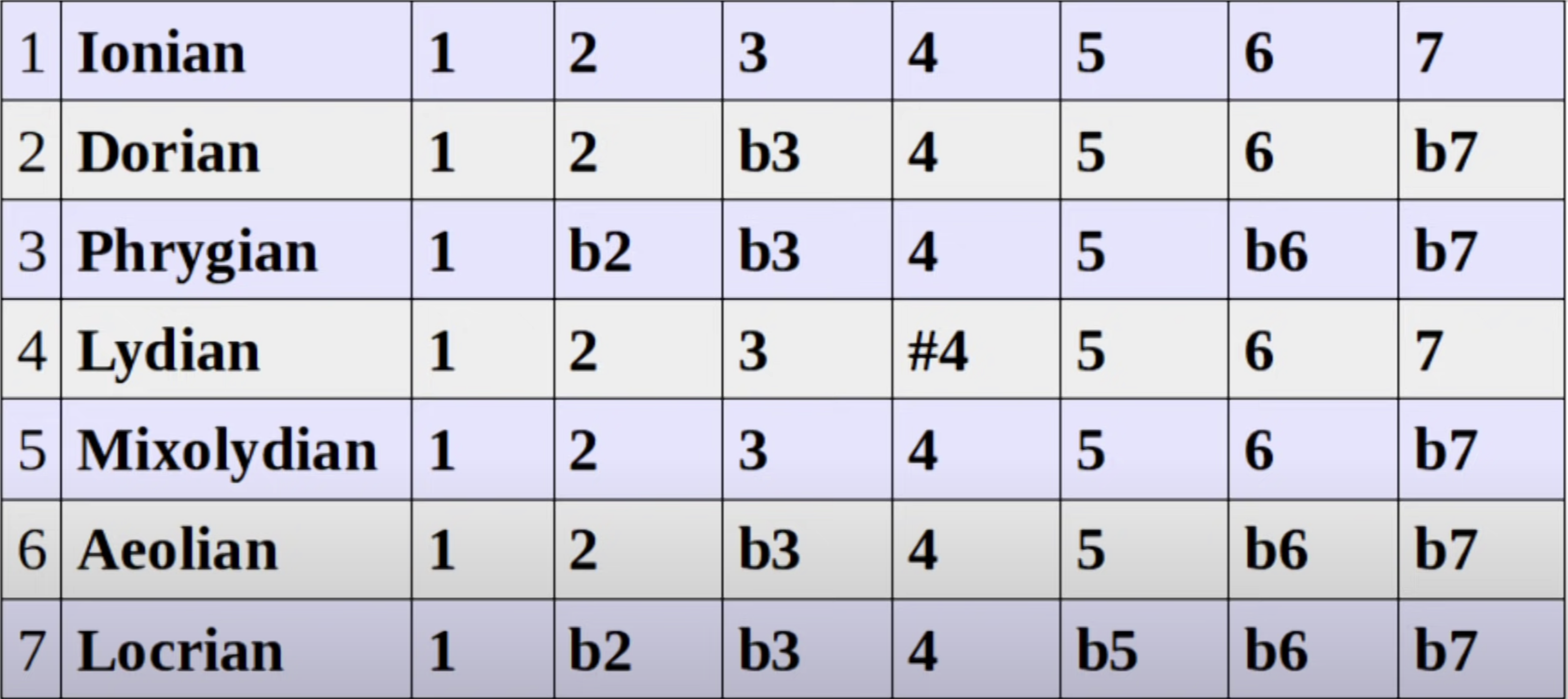Modes
each mode has one more lowered interval relative to the tonic than the mode preceding it. Taking Lydian as reference,
- Ionian (ie. major) has a lowered fourth;
- Mixolydian, a lowered fourth and seventh;
- Dorian, a lowered fourth, seventh, and third;
- Aeolian (ie. natural minor), a lowered fourth, seventh, third, and sixth;
- Phrygian, a lowered fourth, seventh, third, sixth, and second;
- Locrian, a lowered fourth, seventh, third, sixth, second, and fifth.
Put another way, the augmented fourth of the Lydian mode has been reduced to a perfect fourth in Ionian, the major seventh in Ionian to a minor seventh in Mixolydian
All diatonic modes follow the repeating pattern wwhwwwh, with the only difference being which letter we start on
- ie. in other words, to switch from Ionian to Lydian, we need to shift to the right 4 times, and
wwhwwwhbecomeswwhwwhw
Modal Interchange (ie. Borrowed Chords)
Borrowed chords are distinguished from modulation by being brief enough that the tonic is not lost or displaced, and may be considered brief or transitory modulations
If we are playing in the key of D major, we could borrow from...
- D Dorian
- D Phrygian
- D Lydian
- D Mixolydian
- etc.
The Modes

From brightest to darkest (following circle of fifths), the modes are:
- Lydian
- Ionian
- Mixolydian
- Dorian
- Aeolian
- Phrygian
- Locrian
nm: I Dont Pee Like Most Alien Ladies
Dorian
The same as Aeolian (minor), except with a natural 6th, making it sound a little bit less dark
Dorian is commonly found in funk, where it is more common that Aeolian.
Examples
- Riders on the Storm (descending keyboard line during intro @ 0:33)
- No Quarter - Led Zeppelin
- Thriller michael jackson
- Eleanor Rigby
Phrygian
The same as Aeolian (minor), except with a flattened 2nd
Much Flamenco music is in the Phrygian mode, though frequently with the third and seventh degrees raised by a semitone.
Lydian
Very similar to Ionian, with the only difference being a sharpened 4th, making a tritone interval with the tonic.
Aeolian
In the aeolian key the v chord is minor this results in it lacking the leading tone which when played shows a not very strong pull to the i. so for this reason often times v is made to be major. by making the v chord major we introduce (or reintroduce) a regular seven as opposed to the flat seven that is found in a natural minor scale This restores the total pole that the v has for pulling it back to one. Essentially, we are moving from the natural minor scale to the harmonic minor scale.
Just because we play a V (or V7) in a minor key doesn’t mean we can’t play the flattened 7th in the melody. In fact, both the flattened 7 and the natural 7 can work over the V7